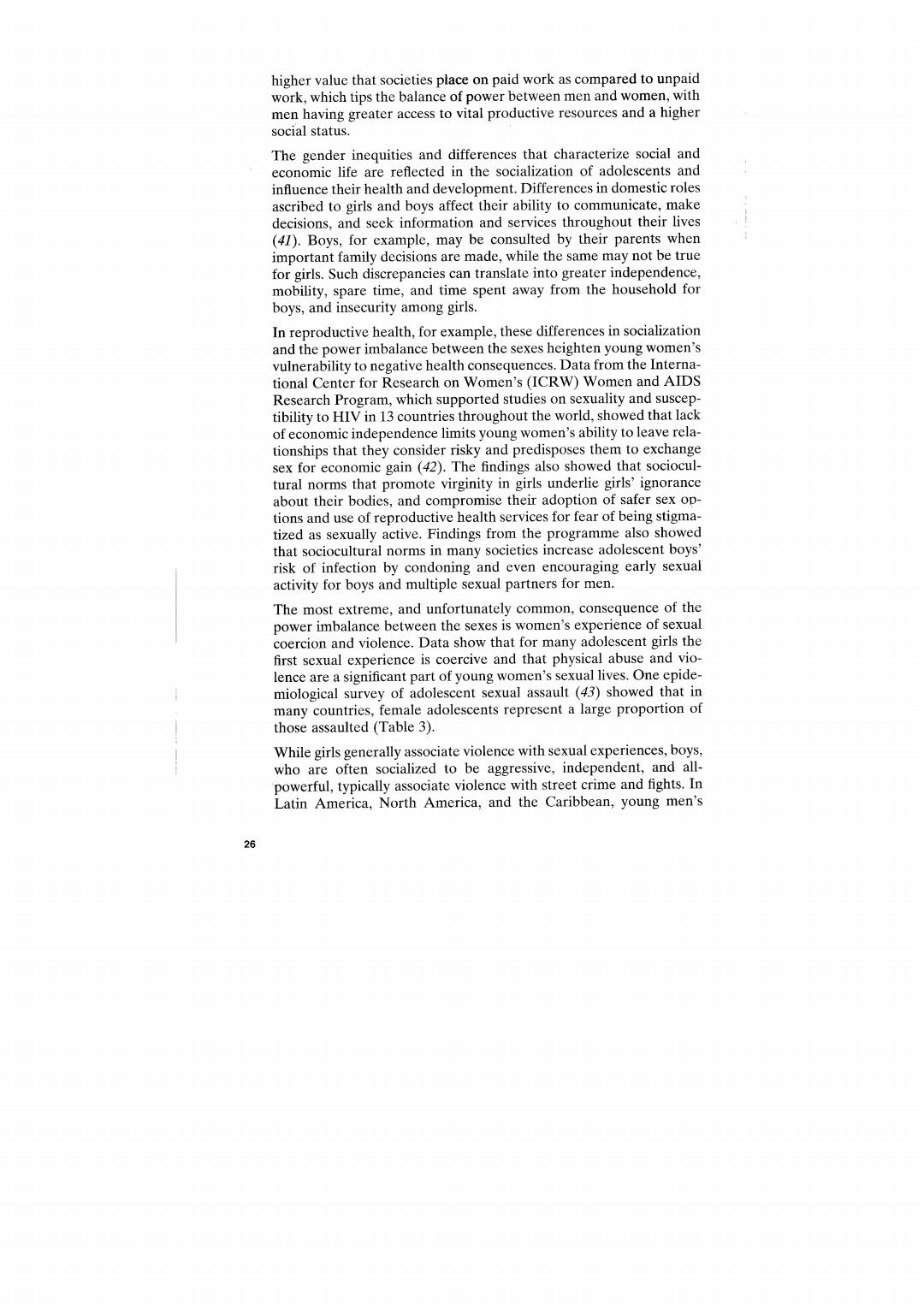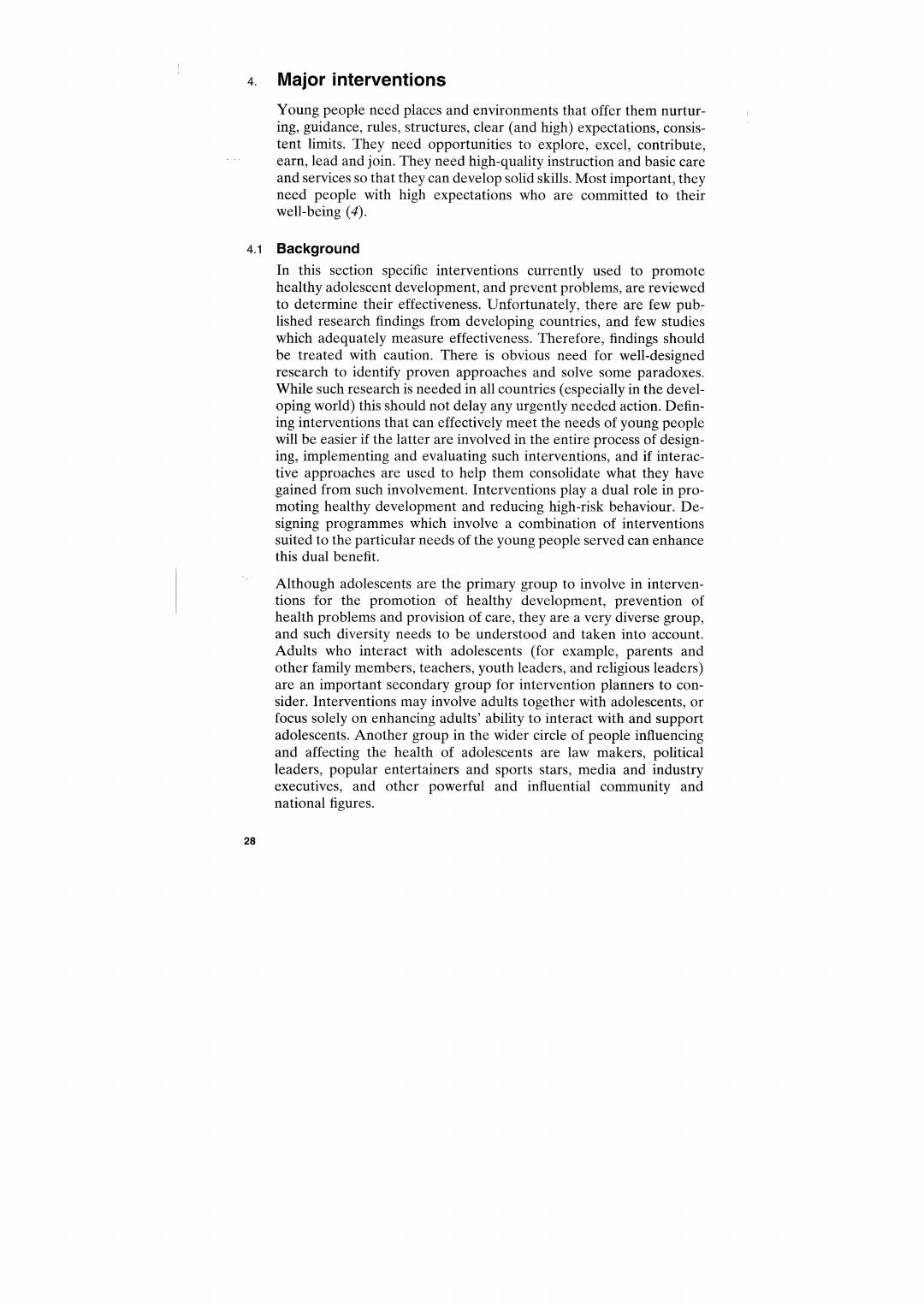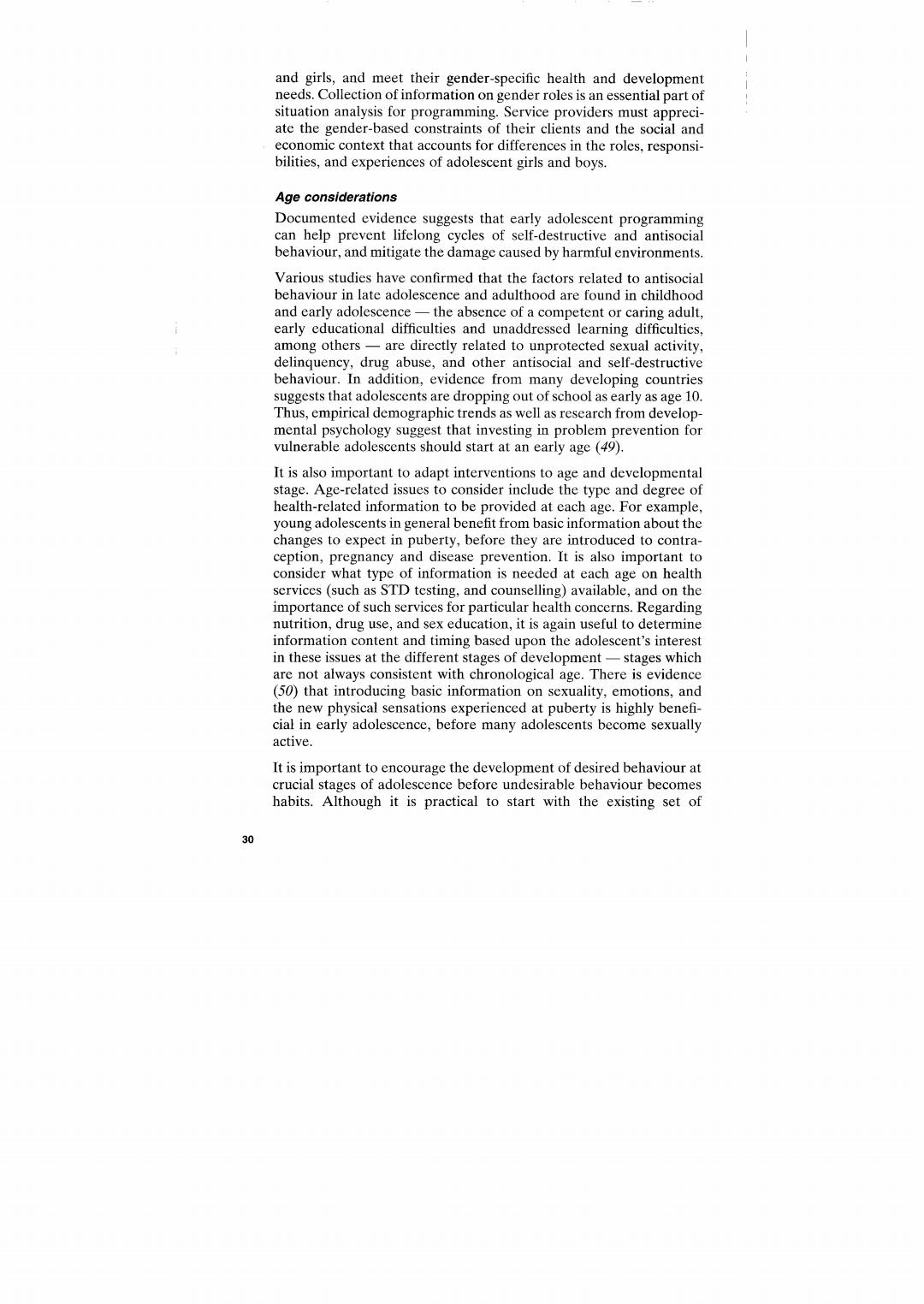
higher value that societies place on paid work as compared to unpaid work,which tips the balance of power between men and women,with men having greater access to vital productive resources and a higher social status. The gender inequities and differences that characterize social and economic life are reflected in the socialization of adolescents and influence their health and development.Differences in domestic roles ascribed to girls and boys affect their ability to communicate,make decisions,and seek information and services throughout their lives (41).Boys,for example,may be consulted by their parents when important family decisions are made,while the same may not be true for girls.Such discrepancies can translate into greater independence, mobility,spare time,and time spent away from the household for boys,and insecurity among girls. In reproductive health,for example,these differences in socialization and the power imbalance between the sexes heighten young women's vulnerability to negative health consequences.Data from the Interna- tional Center for Research on Women's(ICRW)Women and AIDS Research Program,which supported studies on sexuality and suscep- tibility to HIV in 13 countries throughout the world,showed that lack of economic independence limits young women's ability to leave rela- tionships that they consider risky and predisposes them to exchange sex for economic gain (42).The findings also showed that sociocul- tural norms that promote virginity in girls underlie girls'ignorance about their bodies,and compromise their adoption of safer sex op- tions and use of reproductive health services for fear of being stigma- tized as sexually active.Findings from the programme also showed that sociocultural norms in many societies increase adolescent boys' risk of infection by condoning and even encouraging early sexual activity for boys and multiple sexual partners for men The most extreme,and unfortunately common,consequence of the power imbalance between the sexes is women's experience of sexual coercion and violence.Data show that for many adolescent girls the first sexual experience is coercive and that physical abuse and vio- lence are a significant part of young women's sexual lives.One epide- miological survey of adolescent sexual assault (43)showed that in many countries,female adolescents represent a large proportion of those assaulted (Table 3). While girls generally associate violence with sexual experiences,boys, who are often socialized to be aggressive,independent,and all- powerful,typically associate violence with street crime and fights.In Latin America,North America,and the Caribbean,young men's 26

Table 3 Statistics on sex crimes(43) Country Victims aged 15 or less (% Victims aged 10 or less (% Chile(Santiago】 58 3 Malaysia 58 18 Mexico(City 2 Panama(City) 40 N.a Papua New Guinea 47 Peru (Lima) N.a. United States 62 28 N.a.:Not aveilable mortality rates range from two to seven times higher than young women's.The leading causes of mortality for young men in the region are traffic accidents and homicides-both associated with gender socialization (44). Gender differences also influence the nutritional status of adoles- cents.In countries,such as those in southern Asia,where preference for the male offspring is the norm,evidence indicates that girls'di- etary intake is different from boys'both in quantity and quality- girls are typically fed less and last.The situation,however,can be more complex than it first seems.Recent research on the nutritional status of adolescents noted gender differences in the biological and social indicators of nutritional status.Adolescent boys appeared to have nutritional deficiencies more frequently than girls and in some sites showed higher levels of stunting.Girls.on the other hand,attain lower education levels,which is a key determinant of nutritional status (45). There is growing recognition of the needs of boys,and of the role their socialization plays in health behaviour.Some researchers have associated boys'inability to meet societal and familial ex- pectations of the role of "real men"with risk-taking and violent behaviour and suggested that young men from low-income back- grounds may resort to violence or drug use to gain prestige and self- esteem (46). Programmes must be gender-sensitive,so as to ensure that the needs of both girls and boys are addressed in programmes.Because of correlations between school attendance.health status and fertility, efforts should help to promote equality between the sexes with a view to empowering girls.On the other hand.boys should be empowered to reject "machismo"attitudes (and embrace nurturing),while par- ents and communities must be equipped to give their children a balanced upbringing

4.Major interventions Young people need places and environments that offer them nurtur ing,guidance,rules,structures,clear (and high)expectations,consis. tent limits.They need opportunities to explore,excel,contribute. earn,lead and join.They need high-quality instruction and basic care and services so that they can develop solid skills.Most important,they need people with high expectations who are committed to their well-being (4). 4.1 Background In this section specific interventions currently used to promote healthy adolescent development,and prevent problems.are reviewed to determine their effectiveness.Unfortunately,there are few pub lished research findings from developing countries,and few studies which adequately measure effectiveness.Therefore,findings should be treated with caution.There is obvious need for well-designed research to identify proven approaches and solve some paradoxes. While such research is needed in all countries(especially in the devel- oping world)this should not delay any urgently needed action.Defin- ing interventions that can effectively meet the needs of young people will be easier if the latter are involved in the entire process of design- ing,implementing and evaluating such interventions,and if interac- tive approaches are used to help them consolidate what they have gained from such involvement.Interventions play a dual role in pro- moting healthy development and reducing high-risk behaviour.De- signing programmes which involve a combination of interventions suited to the particular needs of the young people served can enhance this dual benefit. Although adolescents are the primary group to involve in interven- tions for the promotion of healthy development,prevention of health problems and provision of care,they are a very diverse group, and such diversity needs to be understood and taken into account. Adults who interact with adolescents (for example,parents and other family members,teachers,youth leaders,and religious leaders) are an important secondary group for intervention planners to con- sider.Interventions may involve adults together with adolescents,or focus solely on enhancing adults'ability to interact with and support adolescents.Another group in the wider circle of people influencing and affecting the health of adolescents are law makers,political leaders,popular entertainers and sports stars,media and industry executives,and other powerful and influential community and national figures. 28

It is necessary to consider the specific situation of each group of the adolescent population to ensure that interventions address relevant concerns and needs.The type of intervention,activities and ap- proaches used can vary according to gender,age,state of health, marital status,home and social situations.Careful consideration of the needs of particular adolescent population groups is essential to the planning of interventions.The following are the major factors which segment the adolescent population,and an illustration of the role of these divisions in the selection and use of interventions. Gender considerations As the social face of biological sex differences,gender must be consid ered when programming for adolescent health.Girls tend to suffer more as a consequence of problematic behaviours associated with unprotected sex,overnourishment and undernourishment and sub- stance abuse.Girls often have less access to education than boys, which denies them the opportunity to develop to their full potential. Factors with special risks for the adolescent girl include nutrition, sexuality,pregnancy and childbirth,abortion,STDs(including HIV/ AIDS),female genital mutilation,early marriage,substance abuse, and mental illness (47). Gender is also an important determinant of the utilization of social and health services.Access to services can be greatly constrained for young women by factors such as reduced mobility (making distance an insurmountable barrier)and competing demands on their time because of domestic work and the care of younger siblings.To over- come these gender-based constraints,the particular circumstances of young women need to be considered.For example,services could be provided at times that are convenient for young women;services may be integrated to minimize the time women spend on a variety of services;and whenever possible,community outreach services should be provided to remove the distance barrier to access. Young men,too,face gender-based constraints to their use of ser- vices.Emphasis on the reproductive role of women,to the exclusion of men,means that men often do not have access to reproductive health services.A review of interventions to reduce early and un- wanted pregnancies in English-speaking Caribbean countries noted the lack of attention to young men.Interventions excluded males or overlooked their role in adolescent pregnancy (48) In order to best address adolescent health needs,programmes should acknowledge the gender-based differences highlighted above,to identify the appropriate interventions and approaches to reach boys 29

and girls,and meet their gender-specific health and development needs.Collection of information on gender roles is an essential part of situation analysis for programming.Service providers must appreci- ate the gender-based constraints of their clients and the social and economic context that accounts for differences in the roles,responsi- bilities,and experiences of adolescent girls and boys. Age considerations Documented evidence suggests that early adolescent programming can help prevent lifelong cycles of self-destructive and antisocial behaviour,and mitigate the damage caused by harmful environments. Various studies have confirmed that the factors related to antisocial behaviour in late adolescence and adulthood are found in childhood and early adolescence-the absence of a competent or caring adult. early educational difficulties and unaddressed learning difficulties. among others-are directly related to unprotected sexual activity. delinquency,drug abuse,and other antisocial and self-destructive behaviour.In addition,evidence from many developing countries suggests that adolescents are dropping out of school as early as age 10. Thus,empirical demographic trends as well as research from develop- mental psychology suggest that investing in problem prevention for vulnerable adolescents should start at an early age (49). It is also important to adapt interventions to age and developmental stage.Age-related issues to consider include the type and degree of health-related information to be provided at each age.For example, young adolescents in general benefit from basic information about the changes to expect in puberty,before they are introduced to contra- ception,pregnancy and disease prevention.It is also important to consider what type of information is needed at each age on health services (such as STD testing,and counselling)available,and on the importance of such services for particular health concerns.Regarding nutrition,drug use,and sex education,it is again useful to determine information content and timing based upon the adolescent's interest in these issues at the different stages of development-stages which are not always consistent with chronological age.There is evidence (50)that introducing basic information on sexuality,emotions,and the new physical sensations experienced at puberty is highly benefi- cial in early adolescence,before many adolescents become sexually active. It is important to encourage the development of desired behaviour at crucial stages of adolescence before undesirable behaviour becomes habits.Although it is practical to start with the existing set of